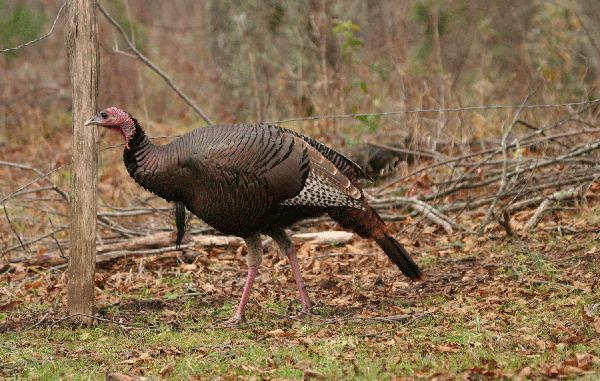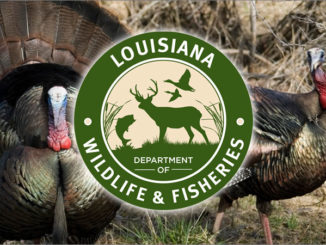
Poachers draw turkeys in illegally
The spring gobbler season begins in March and is the last hunting season before agents move almost entirely to the water for enforcement of fishing and boating regulations for spring and summer.
The 2012 spring turkey season dates and license requirements are: Area A, March 24-April 22; Area B, March 24-April 15; Area C, March 24-April 8. The Private Land Youth and Physically Challenged season dates are March 17 and 18 in all three areas. The required licenses are Basic Season, Big Game and Wild Turkey with Turkey Carcass Tags. Find more information and regulations online at http://www.wlf.louisiana.gov/ or in the Louisiana Turkey Hunting Regulations pamphlet.
The two enforcement issues associated with gobbler hunting are illegal baiting and the daily and season bag limits. Baiting is the bigger problem for both hunters and wildlife agents. But first, here is a little Louisiana turkey history.
During the 1970s and early ’80s Louisiana Department of Wildlife and Fisheries personnel were aggressively trapping and relocating wild turkeys in an effort to re-establish them in their historic range and in good turkey habitat. It was a popular effort supported by hunters, landowners and the National Wild Turkey Federation. Many LDWF employees, including some enforcement agents who volunteered their time, worked long hours to get the job done.
Turkey populations began to rise quickly in Central Louisiana, where I grew up and patrolled as a wildlife agent. The spring season was anticipated by a growing number of hunters. In those days, turkey hunting was a new experience and instances of illegal baiting were not very common in this part of the state. However, turkey seasons had been open in Southeast Louisiana for a number of years and agents there were routinely making baiting cases. The word from them was, “Hey, if you have turkeys, you will have bait. It is just a matter of time and knowing where to look.”
Well, they were correct and within a few years, baiting was all too common. Cases were made on both public and private land. They resulted from tips by concerned citizens and a lot of long hikes by wildlife agents combing the countryside looking for grain in the woods. One of those cases came about in the oddest of ways.
One fine spring day about mid-morning, I drove up to the camp and found my best friend, David “Bolo” Parker, sitting on the porch with a puzzled look on his face. He showed me a handful of hen-scratch (commercial chicken feed) and a fine gobbler he had killed on our hunting lease that morning. Bolo had noticed the bulging crop on the gobbler, and upon getting back to the camp he opened it and discovered the chicken feed.
We were both convinced someone had slipped onto our lease and put out bait with plans of poaching a turkey or two off the property. Returning to the area he had hunted, we spent the better part of the day walking the entire area looking for bait. Finding nothing, we returned to the camp and were still mulling over the mystery when another buddy arrived. We told him our story, and he shared some information that made things even more interesting. It seemed he had been driving down the public road that divided our lease from another hunting lease just across the road a couple of days earlier. As he drove by the gate of the neighboring lease, he had seen a truck parked at the roadside and a fellow just leaving the truck, walking down the woods road, carrying a bucket. This was not too far from where Bolo had taken the gobbler. A quick return trip and a stroll down that little woods road solved the mystery.
The same feed was scattered in abundance down the road in front of an elevated box deer stand. Apparently the recently deceased gobbler was quite a traveler, feeding on the scattered grain, before crossing the highway to look for hens on “our” side of the road.
A little surveillance over the next couple of days resulted in citations for two men sitting in the deer stand over the bait. One of them turned out to be the man seen carrying the bucket of feed. What are the odds?
As mentioned earlier, another problem is compliance with the daily and season limits. As we all know, the daily limit is one gobbler and the limit for the season is two. Wildlife agents receive plenty of reports about people exceeding the season limit, and it is indeed very difficult to enforce. Things improved somewhat when turkey carcass tags became a requirement.
The regulations requiring the hunter to have his tags in possession while hunting and placing the tag on the turkey immediately upon taking it are well written and much better than the “honor” system in place before tagging. But we all know even the best tagging system may be beaten, and wildlife agents rely heavily on the assistance of honest sportsmen willing to report violations. Louisiana Operation Game Thief, Inc. and NWTF offer rewards in matching amounts for information leading to the apprehension of turkey violators. Call 800-442 -2511 or contact a wildlife agent for more information.
Hunters concerned with getting caught hunting over bait without being aware of its presence need not be too worried. Agents are well trained in baiting enforcement and making the distinction between the guy who had no idea the area was baited and those who “knew or should have known” bait was present. Stay 200 or more yards from active deer feeders or better yet, empty or turn off deer feeders prior to the opening of turkey season. Also, take a good look around for evidence of bait before hunting in unfamiliar territory. Good luck and safe hunting.

